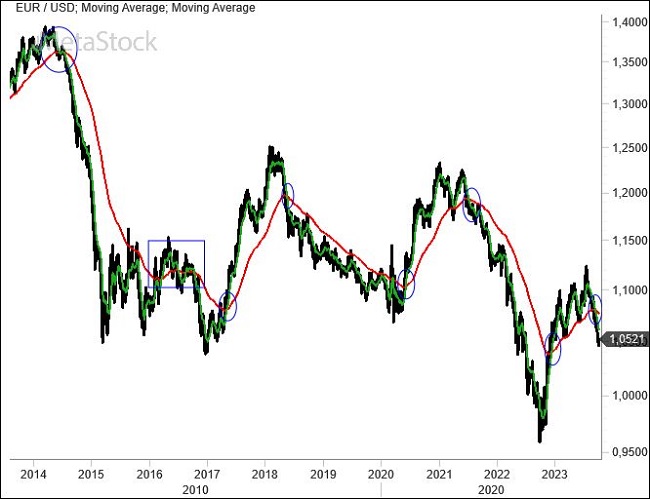- In the U.S., the economy remains buoyant with a strong employment status, positioning the FED to maintain an aggressive monetary policy without foreseeing cuts in the coming months. The dollar is benefiting, but the debt ceiling uncertainty lingers. Meanwhile, tensions escalate following Palestinian attacks on Israel.
- Europe continues to witness a noticeable economic slowdown, likely leading the ECB towards a less restrictive path. The central bank’s end-of-month meeting will provide insights into future directions.
- EurUsd hovers near a significant support zone but confirms a death cross, a technical signal suggesting further declines. There’s potential for short trades on the rebound.
New War Front in Israel
The discontent with the strong dollar is beginning to show on some emerging market currencies that have so far benefited from large inflows (such as South American currencies). Yet, it’s also noticeable on currencies from the developed world like the yen. Here, a tug of war between the market (pushing USDJPY resistance to 150) and the Bank of Japan (intervening at this level by selling yen) has begun and promises to linger throughout the fall.
Tensions are also emerging within Europe, where the spread between Italian and German government bonds has reached 200 basis points. The performance of peripheral bonds is a crucial gauge of the stress on the euro, which has intensified again.
The Eurozone is evidently grappling with an economic slowdown leading to a recession. Regional PMIs below 50 points and Eurozone retail sales still in negative growth confirm this. However, the central bank has reaffirmed through Lagarde that interest rates will remain high as long as necessary. While there will be no interventions on October 26, the market anticipates some news about the 2024 strategy.
Meanwhile, in America, the “shutdown” delaying tactics continue, with a postponement to November. This does not address a recurring issue that constantly challenges the country’s political and economic balance.
Biden faces potential weakening during this unstable phase, with the ongoing war in Ukraine in the backdrop and a new conflict emerging in Israel after terrorist attacks by Palestinians. These conflicts consume significant American financial resources. Despite this, the FED remains steadfast in its monetary policy, committed to combating inflation. Meanwhile, employment is surging, with the number of new paychecks issued in September doubling expectations—further fuel for inflation.
The economy, meanwhile, continues to show unmistakable signs of resilience. The US ISM Manufacturing Index recorded a positive figure above 53 points, and the ISM Services Index rose for the third consecutive month. For now, monetary policy hasn’t significantly impacted the economy or inflation.
EurUsd Technical Analysis – The ‘Death Cross’ Is Now a Reality
EurUsd has experienced a clear and pronounced bearish break, characterized by the ‘death cross’ where the 20-day moving average fell below the 200-day moving average. This signal, in the past decade, only had a false start in 2016. In all other instances, whether bullish or bearish, it typically signaled a continuation of the dominant trend for several more weeks.
The 50% retracement of the euro’s bull market, which began in 2022, is not far off (1.041). However, we wouldn’t rule out a move to the 61.8% mark of 1.022, given that the sentiment on the European single currency isn’t overwhelmingly negative, and non-commercials continue to remain net long.

EurUsd (daily chart) – death cross signaling further downside risks for the euro.
The ADX above 30 indicates strength in the bearish trend of EurUsd, which took a breather towards the week’s end. With three bullish sessions, the euro returns to test the 20-day moving average, which, according to trading theory, should be the optimal point to go short and exploit the short-term negative trend. Surpassing 1.06 would take us back to 1.076, where the critical 200-day moving average lies. Until then, shorting EurUsd is the preferred stance.

EurUsd (daily chart) – the bearish trend gains momentum and encounters initial resistance.


Leave a Reply
You must be logged in to post a comment.